| Karkee Web Home Page | Officer's Main Page | W.E.O. Main Page | W.E.O. Experimental Main Page |
Web Equipment, Officers, Experimental
Equipment Carriers
Mills designed two assemblies, whose basic form would not change for over a decade, until Web Equipment, Royal Artillery split the assemblies into their four component parts. One of these, designed to fit onto the right-hand Side piece, was composed of a Binocular case and Compass pocket, whilst the left-hand assembly comprised a Pistol case and Cartridge pouch. Both were fitted with 4-bar buckles on web chapes, so that the assembled Braces could pass behind the assemblies and through the rings of the Brace attachments. Except where otherwise noted, all items shown on this page are from the Paul Hannon collection, photographs © Paul Hannon 2010.
Case, binocular
“Case, binocular, with Pocket, compass”
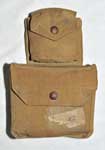
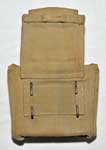

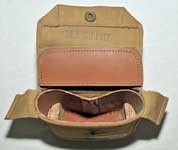 The Vocabulary listing omits any reference to a Compass pocket, so the second form above has been ascribed, which would have been more descriptive. This right-hand assembly comprised a Compass pocket stitched permanently to the upper edge of a Binocular case, with the simplified nomenclature of Case, binocular. Each was closed by a plain flap, secured by a press fastener. The rear face of the Binocular case carried a pair of “C” hooks and the upper edge of the Compass pocket had a horizontal narrow web loop. This last was positioned to align exactly with the brass ring joining the upper and lower parts of the Brace attachment. It was also stitched at four points along its length, creating a very tight loop for the Brace attachment ring. The Case illustrated here is noticeably on the small side, but it is unknown if different sizes were on offer. It is entirely likely that Mills would have accommodated different requirements. The lid has a section of vulcanised fibreboard stitched to it and an internal fibreboard sleeve, with a stitched in base, is fitted inside. In the corners, there are two cork support pads for the shoulders of the inverted prismatic binoculars. For additional weather proofing, the material forming the sides and base of the Case are extended into short flaps.
The Vocabulary listing omits any reference to a Compass pocket, so the second form above has been ascribed, which would have been more descriptive. This right-hand assembly comprised a Compass pocket stitched permanently to the upper edge of a Binocular case, with the simplified nomenclature of Case, binocular. Each was closed by a plain flap, secured by a press fastener. The rear face of the Binocular case carried a pair of “C” hooks and the upper edge of the Compass pocket had a horizontal narrow web loop. This last was positioned to align exactly with the brass ring joining the upper and lower parts of the Brace attachment. It was also stitched at four points along its length, creating a very tight loop for the Brace attachment ring. The Case illustrated here is noticeably on the small side, but it is unknown if different sizes were on offer. It is entirely likely that Mills would have accommodated different requirements. The lid has a section of vulcanised fibreboard stitched to it and an internal fibreboard sleeve, with a stitched in base, is fitted inside. In the corners, there are two cork support pads for the shoulders of the inverted prismatic binoculars. For additional weather proofing, the material forming the sides and base of the Case are extended into short flaps.
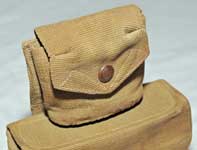
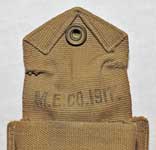 The Compass pocket, in this example, is not lined with felt and has a simple flap. This has been crudely gathered into a dart on each side, to give the flap a more “hooded” form – not very successfully.
The Compass pocket, in this example, is not lined with felt and has a simple flap. This has been crudely gathered into a dart on each side, to give the flap a more “hooded” form – not very successfully.
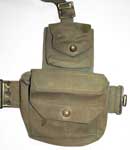
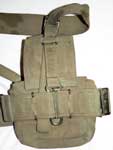 Another example of the Binocular case has emerged, this one without the vulcanised fibreboard inner lining in the body of the Case, although it is present on the lid. Whilst there is no indication that the fibre lining was ever present, Paul Hannon has noted that the liner is sewn to the body at only two small places, making removal a relatively simple process, and the wear and usage marks inside could conceal the marks left by removal. Given Mill's known willingness to accommodate special design requests, it is possible that they could have made a Case in this form if asked, but it seems more likely that this is a "user mod" to accommodate a large private purchase pair of binoculars. KW would appreciate any information, or photos of other examples of this type of Case. This example is maker marked "M.E. Co." and dated 1917. Photos supplied by a collector who wishes to remain anonymous. Photos © Karkee Web 2011.
Another example of the Binocular case has emerged, this one without the vulcanised fibreboard inner lining in the body of the Case, although it is present on the lid. Whilst there is no indication that the fibre lining was ever present, Paul Hannon has noted that the liner is sewn to the body at only two small places, making removal a relatively simple process, and the wear and usage marks inside could conceal the marks left by removal. Given Mill's known willingness to accommodate special design requests, it is possible that they could have made a Case in this form if asked, but it seems more likely that this is a "user mod" to accommodate a large private purchase pair of binoculars. KW would appreciate any information, or photos of other examples of this type of Case. This example is maker marked "M.E. Co." and dated 1917. Photos supplied by a collector who wishes to remain anonymous. Photos © Karkee Web 2011.
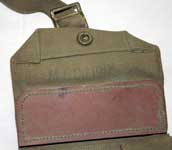
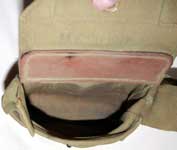 Additional photos of this Case, binocular.
Additional photos of this Case, binocular.



 This is by way of a force-fit. The nomenclature is un-promising, just for having “Sam Browne” – why? If it was intended to be a generic - Pouches (for) Pistol (and Ammunition), it just about holds water. On this un-comfortable premise, I move on!
This is by way of a force-fit. The nomenclature is un-promising, just for having “Sam Browne” – why? If it was intended to be a generic - Pouches (for) Pistol (and Ammunition), it just about holds water. On this un-comfortable premise, I move on!
 The left-hand assembly would more usefully have been termed a holster, or the standard form, pistol case. Quite why reference was made to Sam Browne is not known, since its angular form did not resemble the elegantly curved Case, pistol of Sam Browne equipment. What is of interest is that it was completely flat, being woven in the manner of the Patt. ’13 Carrier section for the Sirhind tool head. Perhaps this was why Mills did not choose to grace the item with other than “pouch”, since it was little advanced on one and certainly not in the same league as a stiff, leather Case. The lower end is woven as a closed envelope, with the lower corners turned inside the seam and stitched into place. It is otherwise clearly of the shape that would later characterise all Mills’ pistol holsters. Internal strips of webbing were added, stitched inside, to obviate undue wear and tear from the foresight, etc. A small pocket, for 12 pistol rounds, with a horizontal web loop, identical to the Compass pocket, was stitched to the upper rear face of the holster, which also had “C” hooks. Revolver ammunition was in paper packets of six rounds and the “hooded” simple flap did little for either weather-proofing, or security.
The left-hand assembly would more usefully have been termed a holster, or the standard form, pistol case. Quite why reference was made to Sam Browne is not known, since its angular form did not resemble the elegantly curved Case, pistol of Sam Browne equipment. What is of interest is that it was completely flat, being woven in the manner of the Patt. ’13 Carrier section for the Sirhind tool head. Perhaps this was why Mills did not choose to grace the item with other than “pouch”, since it was little advanced on one and certainly not in the same league as a stiff, leather Case. The lower end is woven as a closed envelope, with the lower corners turned inside the seam and stitched into place. It is otherwise clearly of the shape that would later characterise all Mills’ pistol holsters. Internal strips of webbing were added, stitched inside, to obviate undue wear and tear from the foresight, etc. A small pocket, for 12 pistol rounds, with a horizontal web loop, identical to the Compass pocket, was stitched to the upper rear face of the holster, which also had “C” hooks. Revolver ammunition was in paper packets of six rounds and the “hooded” simple flap did little for either weather-proofing, or security.
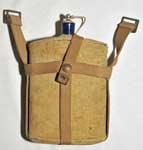

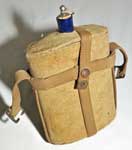 The Vocabulary price was 2s 2d, exactly the price of the standard Patt. ’08 type. The design here was of framework form, front fastened, being a derivative of similar designs in Mills’ lightweight designs, such as Naval Patt. ‘19. It had 1-inch buckles to attach to the Brace ends. With less materials, both webbing and brass, the price might have been expected to be lower, but perhaps the extra finishing took up the slack? The carrier took the standard Bottle, water, enamelled (Mark VI.), although examples of superior forms of this are known, for retail to officers. An example of such a commercial Mk. VI Bottle is shown at right.
The Vocabulary price was 2s 2d, exactly the price of the standard Patt. ’08 type. The design here was of framework form, front fastened, being a derivative of similar designs in Mills’ lightweight designs, such as Naval Patt. ‘19. It had 1-inch buckles to attach to the Brace ends. With less materials, both webbing and brass, the price might have been expected to be lower, but perhaps the extra finishing took up the slack? The carrier took the standard Bottle, water, enamelled (Mark VI.), although examples of superior forms of this are known, for retail to officers. An example of such a commercial Mk. VI Bottle is shown at right.

 The listing is for a Bayonet frog, not for a Sword frog. This is clearly illustrated in the Hazell advertisement shown at right. Swords and therefore their frogs, had been abandoned early in the Great War, officers being encouraged / ordered to carry rifles. Sword frogs did reappear in the post-war versions of W.E.O., but so far have not been noted in the Great War examples. The Frog is missing from Paul Hannon's set, but is present on the example here, from the collection of an anynomous American collector, photo © John Pierson, 2007. It was of standard Patt. ’08 form, which cost 1s 3d. The officer version is not fitted with the tab for the Entrenching tool helve carrier. These tabs were 1s 4d per dozen, or approximately 1.33 pence each, which accounts for the officer version being cheaper by tuppence. The one Hazell advertisement curiously illustrates a bayonet of Patt. 1903 length, 5 inches shorter than the O.R.'s Patt. ’07 Bayonet. As was the case in the Boer War, officers were encouraged to arm themselves with a rifle, albeit no provision for ammunition carriage was made in W.E.O. It might conceivably be for a sheath knife, many officers being photographed with these. Perhaps they’d been Boy Scouts before the War?!
The listing is for a Bayonet frog, not for a Sword frog. This is clearly illustrated in the Hazell advertisement shown at right. Swords and therefore their frogs, had been abandoned early in the Great War, officers being encouraged / ordered to carry rifles. Sword frogs did reappear in the post-war versions of W.E.O., but so far have not been noted in the Great War examples. The Frog is missing from Paul Hannon's set, but is present on the example here, from the collection of an anynomous American collector, photo © John Pierson, 2007. It was of standard Patt. ’08 form, which cost 1s 3d. The officer version is not fitted with the tab for the Entrenching tool helve carrier. These tabs were 1s 4d per dozen, or approximately 1.33 pence each, which accounts for the officer version being cheaper by tuppence. The one Hazell advertisement curiously illustrates a bayonet of Patt. 1903 length, 5 inches shorter than the O.R.'s Patt. ’07 Bayonet. As was the case in the Boer War, officers were encouraged to arm themselves with a rifle, albeit no provision for ammunition carriage was made in W.E.O. It might conceivably be for a sheath knife, many officers being photographed with these. Perhaps they’d been Boy Scouts before the War?!
© R.J. Dennis February 2009